John A. Keel Has Died
Posted by: Loren Coleman on July 6th, 2009
John Alva Keel, 79, a friend, Fortean, fierce fighter for his theories, professionally a writer and journalist, has died. A fellow admirer of Mothman and the anomalies all around us, such as the “name game,” is gone.
Keel, who lived most of his life in New York City, passed away on Friday, July 3, 2009, at Mount Sinai Hospital in New York City, after some months in a nursing home near his Upper West Side apartment.

In 1994, John A. Keel made a rare appearance at a birthday celebration held in his honor among a few of his closest friends. Pictured are J. Antonio Huneeus, Keel, and Loren Coleman. Photo by Patrick Huyghe.
Born Alva John Kiehle in upstate New York on March 25, 1930, John Keel began writing at a young age. Indeed, Keel’s first published story was in a magician’s magazine at the age of 12.
Keel would go on to become a scriptwriter for radio and television, and a stringer for newspapers. He later moved to Greenwich Village and wrote for various men’s and speciality magazines.
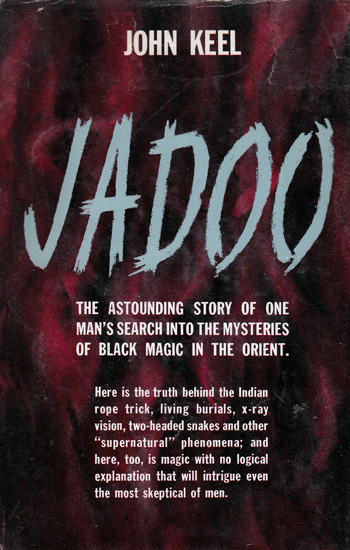
Keel’s first published book was Jadoo in 1957, which was quickly serialized in a men’s adventure magazine. The paperback is his account of his journey of discovery to India to investigate the alleged activities of fakirs and holy men who perform the Indian rope trick and who survive being buried alive. In Jadoo, Keel also told of tracking a Yeti, an Abominable Snowman, in the jungles of Asia.
John A. Keel’s non-fiction look at the very real unplanned twists in life were recorded in his 1966 novel, The Fickle Finger of Fate. It is a rare book, and few realize that Keel wrote this book.
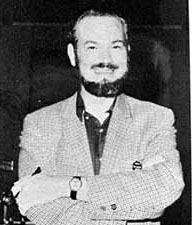
Keel was an early admirer of Charles Fort (1874-1932), and while still doing the mainstream writing, began authoring articles for England’s Flying Saucer Review (FSR) and a long series of columns for Saga.
Further influenced by Fortean Ivan T. Sanderson and ufologist Aimé Michel, in early 1966, John Keel commenced a full-time investigation of monster, aerial and paranormal phenomena. Over a four-year period, Keel interviewed thousands of people in over twenty U.S. states, especially in the Ohio River Valley of the United States. More than 2,000 books were reviewed in the course of his investigation, in addition to thousands of magazines, newsletters, and newspapers. Keel also subscribed to several newspaper-clipping services, which often generated up to 150 clippings for a single day during the 1966 and 1967 UFO “wave.” Besides FSR, Keel wrote for several magazines including Saga with one 1967 article “UFO Agents of Terror” referring to the Men in Black. He also wrote one of the first articles on Mothman in FSR, during this same time period.

Like other contemporary 1960s researchers such as J. Allen Hynek and Jacques Vallée, Keel was initially hopeful that he could somehow validate the prevailing nuts-and-bolts, extraterrestrial visitation hypothesis for UFOs. However, a year into his investigations, Keel realized that the extraterrestrial hypothesis was untenable and did not explain, for him, based within his personality and belief systems, all the answers.

Keel’s insights also included his view of cryptozoology.
I grew to know Keel after being introduced to him through mutual friends Brad Steiger and Ivan Sanderson. I worked closely with Keel on contributing as yet-unpublished material of mine for his book, Strange Creatures from Time and Space (1970), which would influence my and Jerome Clark’s first two books The Unidentified (1975) and Creatures from the Outer Edge (1978).
Keel’s impact is far-reaching. Keel’s book, Strange Creatures from Time and Space was the inspiration for Craig Woolheater’s interest in Bigfoot and eventually would stimulate the creation of Cryptomundo.
Love him or hate him, John Keel was popular and one of the most widely read and influential Fortean authors of the late 20th century. Although his own thoughts about aerial, monster, and associated anomalous phenomena gradually evolved during the 1960s, Keel remained one of ufology’s most original and controversial researchers.
It was Keel’s second book, UFOs: Operation Trojan Horse (1970), that alerted the general public that many aspects of contemporary UFO reports, including humanoid encounters, often paralleled certain ancient folklore and religious encounters. Keel also argued that there is a direct relationship between UFOs and elemental phenomena. Keel informed me often that he did not consider himself a “ufologist,” but a “demonologist.”
“Ufology is just another name for demonology,” John Keel told me, a week before the September 11th attack on the World Trade Center, which occurred just a couple of miles from where he lives.
…as noted in Mothman and Other Curious Encounters, page 114, (NY: Paraview, 2002).

As Keel himself wrote, “I abandoned the extraterrestrial hypothesis in 1967 when my own field investigations disclosed an astonishing overlap between psychic phenomena and UFOs… The objects and apparitions do not necessarily originate on another planet and may not even exist as permanent constructions of matter. It is more likely that we see what we want to see and interpret such visions according to our contemporary beliefs.”
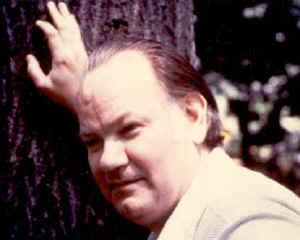
In UFOs: Operation Trojan Horse (1970), Keel argued that a non-human or spiritual intelligence source has staged whole events over a long period of time in order to propagate and reinforce certain erroneous belief systems (mirroring Vallée). Keel conjectured that ultimately all anomalies, such as fairies, 1897 mystery airships, 1930s phantom aeroplanes, mystery helicopters, creatures, poltergeists, balls of light, and UFOs, are a cover for the real phenomenon.
It was during this time period that Keel maintained an enormous and active correspondence with other researchers around the world. For example, I, Loren Coleman, was introduced to my now long-time friend Jerry Clark by John Keel, via letters. These exchanges between Keel and his fellow writers and researchers, even as intellectual disagreements and different paths took many of us on varied journeys, cemented 40 years of solid friendships among a small group of dedicated Fortean writers.
In Our Haunted Planet (1971), Keel coined the term “ultraterrestrials” to describe the UFO occupants. He discussed the seldom-considered possibility that the alien “visitors” to Earth are not visitors at all, but an advanced Earth civilization, which may or may not be human. Keel took no position on the ultimate purpose of the phenomenon other than that the UFO intelligence seems to have a long-standing interest in interacting with the human race.
UFO historian Jerome Clark wrote that Keel was “a radical theorist who believes that UFOs are ‘ultraterrestrial’ rather than extraterrrestrial. By that he means they are shape-changing phenomena from another order of existence. These ultraterrestials are basically hostile to, or at least contemptuous of, human beings and manipulate them in various wasy for example by staging ‘miracles’ which inspire unfounded religious beliefs. Ultraterrestrials and their minions may manifest as monsters, space people, ghosts and other paranormal entities.” (The UFO Encyclopedia, Volume 1: UFOs in the 1980s, page 148, NY: Agogee, 1990).
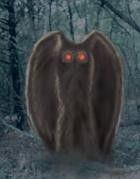
After years of writing parts of the story in various articles and other books, in 1975, Keel published The Mothman Prophecies, an account of his 1966-1967 investigation of sightings of the Mothman, a “winged weirdie” reported in and around Point Pleasant, West Virginia.
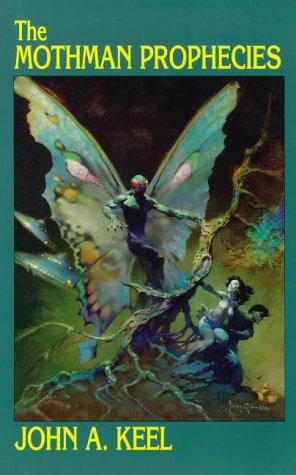
Keel corresponded with Ivan T. Sanderson, quietly for months, trying to determine what kind of bird might be involved with the sightings. It was later, as Keel more fully revealed the tale of the sightings and concurrent phenomena, that other elements came into the mix.
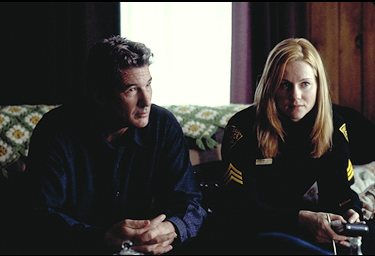
The book was contemporarily adapted into a 2002 movie directed by Mark Pellington, starring Richard Gere, Debra Messing, Laura Linney and Alan Bates.
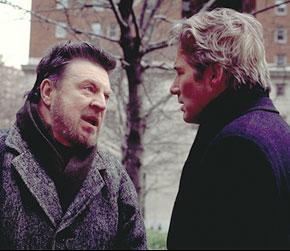
Two parts of Keel’s personality were played by Gere and Bates. Bates’s character was “Leek,” which was “Keel” spelled backwards, and Gere’s character was a newspaperman, “John Klein,” also a play on Keel’s name. Because Keel was ill at the time, Sony/Screen Gems cut back Keel’s schedule of public appearances to only a few televised ones. I assisted Keel by becoming the movie’s publicity spokesperson on 400 radio shows, and appeared with Keel in the David Grabias documentary Search For The Mothman, which is in the Deluxe DVD of The Mothman Prophecies.
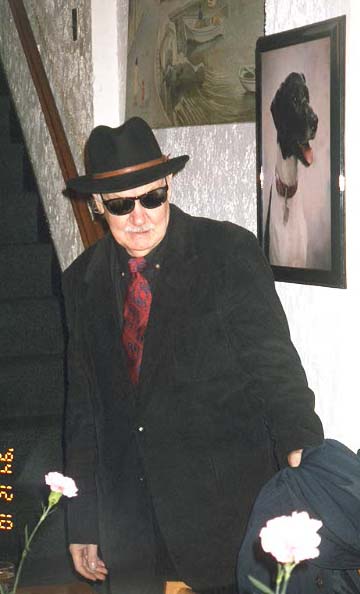
Keel often played, with tongue-in-cheek, on the Men-In-Black interest swirling around his work.
At the time of the release of the movie, a rumor circulated that Keel had died. On January 14, 2002, a story rapidly made the rounds via the web that John A. Keel had just died.

John A. Keel, in 2002.
I quickly put the rumor to rest by calling Keel, and confirming that Keel was, indeed, still alive, although Keel quipped that everyone should be told, “his funeral is on Saturday and he will be wearing black.” Keel told me that this happened to him at least once before, in 1967.
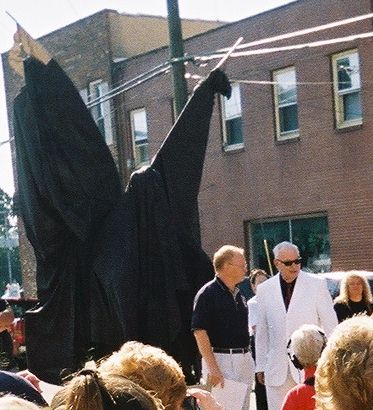
In recent years, Keel’s appearances would be few and far between. But his sense of humor never left him, including wearing an all white suit to the Mothman Festival in Point Pleasant, West Virginia for the unveiling of the new Mothman replica.
Keel suffered a heart attack sometime before October 13, 2006. He admitted himself to New York City’s Lenox Hill Hospital on Friday the 13th of October, and underwent successful heart surgery on October 16, 2006. Keel then was moved from the hospital to a rehabilitation center on October 26, 2006, as his close New York friend Doug Skinner told me soon afterward. Skinner became invaluable in assisting Keel, and passing along messages to and from Keel’s old friends.
Keel’s impact cannot be underestimated, especially in terms of his analysis of patterns. His work on “windows” (specific hotspots of combined phenomenal appearances), “waves” (cyclic appearances of the phenomena), and the “Wednesday phenomenon” (the theory that a disproportionate number of UFO events occur on that day of the week) are deeply influential across time and space. Generations of readers of Fortean literature often do not even realize that Keel’s writings may be behind “name game” discussions or authors’ speculations on the fact that a certain location on a ridge might have a high rate of strange events occurring there after the 21st of the month on a Wednesday in a high-frequency month such as April. Keel was there first trying to look at such patterns.
The popular cultural influence of Keel has been enormous. It shall take future academic studies to fully realize his reach among the subculture that respects and are denizens of his ongoing intellectual playground.
On July 6, 2009, as word swept through the Internet, from Phyllis Benjamin at INFO and others, that Keel had passed away last Friday, tributes and sorrow were shared online in overwhelming fashion from his followers, fans, and friends.
John A. Keel will be missed.
John A. Keel Bibliography
Jadoo. (NY: Tower, 1957)
The Fickle Finger of Fate. (Greenwich, CT: Fawcett, 1966)
UFOs: Operation Trojan Horse. (NY: G. P. Putnam’s Sons, 1970) (reprint, Atlanta: Illuminet Press, 1996)
Strange Creatures From Time and Space. (Greenwich, CT: Fawcett Gold Medal, 1970)
Our Haunted Planet. (1971) (rev., Lakeville, MN: Galde Press, 1999)
The Mothman Prophecies: An Investigation into the Mysterious American Visits of the Infamous Feathery Garuda. (NY: Saturday Review Press/E. P. Dutton, 1975; NY: Signet, 1975), (rev.. NY: Tor, 2002)

The Eighth Tower. (NY: Saturday Review Press/E. P. Dutton, 1975)
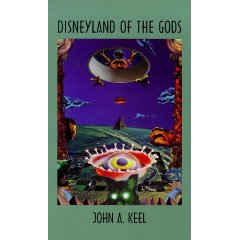
Disneyland of the Gods (NY: Amok Press, 1988) (reprint, Atlanta: Illuminet Press, 1996)
The Complete Guide to Mysterious Beings. (NY: Bantam Doubleday Dell Publishing Group, 1994) (rev. edition of Strange Creatures from Time and Space)
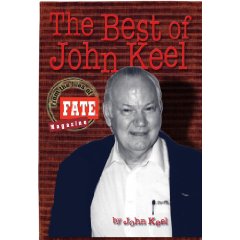
The Best of John Keel. (Lakeville, MN: Galde Press, 2006)
+++
For more on John A. Keel’s legacy, see Chapter Seven, “Keel’s Children” in Mothman and Other Curious Encounters.
For new details on his last days, please see the recently added “Keel Ends Life Rather Alone.”.
About Loren Coleman
Loren Coleman is one of the world’s leading cryptozoologists, some say “the” leading living cryptozoologist. Certainly, he is acknowledged as the current living American researcher and writer who has most popularized cryptozoology in the late 20th and early 21st centuries.
Starting his fieldwork and investigations in 1960, after traveling and trekking extensively in pursuit of cryptozoological mysteries, Coleman began writing to share his experiences in 1969. An honorary member of Ivan T. Sanderson’s Society for the Investigation of the Unexplained in the 1970s, Coleman has been bestowed with similar honorary memberships of the North Idaho College Cryptozoology Club in 1983, and in subsequent years, that of the British Columbia Scientific Cryptozoology Club, CryptoSafari International, and other international organizations. He was also a Life Member and Benefactor of the International Society of Cryptozoology (now-defunct).
Loren Coleman’s daily blog, as a member of the Cryptomundo Team, served as an ongoing avenue of communication for the ever-growing body of cryptozoo news from 2005 through 2013. He returned as an infrequent contributor beginning Halloween week of 2015.
Coleman is the founder in 2003, and current director of the International Cryptozoology Museum in Portland, Maine.

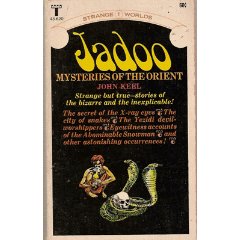
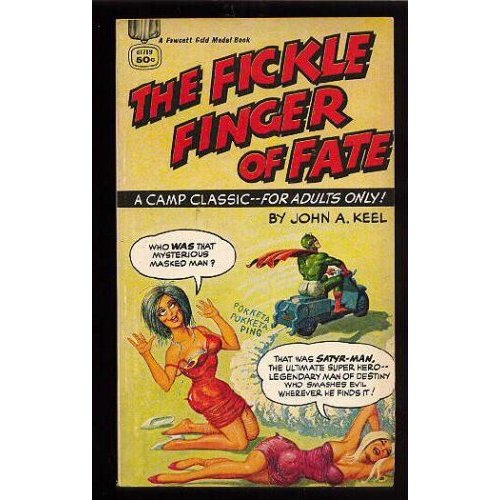

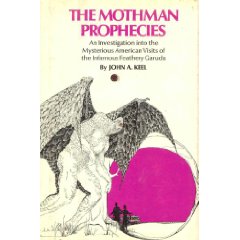










This is very sad news indeed.
As Loren mentions, John Keel was very influential to me in my interest in Bigfoot and cryptozoology. I still remember reading Strange Creatures from Time and Space as a ten year old.
I always felt a special bond with Mr. Keel, as we share a birthday, March 25, he in 1930, myself in 1960.
I never had the privilege of meeting John Keel, and now I never will.
I am especially saddened by that fact.
See: Bigfoot Bayou Boogie Birthday
and
Bigfoot Birthday
Yes, very sad news, indeed.
I dedicated my first book, in part, to John Keel. He was one of my personal Fortean heroes and I have always ranked his writings right up there with that of Charles Fort.
The world has lost one of its greatest today.
Requiscat in Pace, John.
A fitting eulogy for a great man.
I always regretted that Keel never adapted to email, he missed out on a lot of fun.
I remember one time he was telling me how he had constant horizontal lines on his computer monitor. I told him it was EM interference from all the ghosts and ultraterrestrials in his apartment! He did NOT think that was a good joke.
re: name game– One time I mentioned to him that there was a store in the village named Kiehl’s that had motorcycles in the window. He wasn’t just interested, he seemed concerned or something. He was almost as interested in name-coincidences as James Joyce.
When he would speak of Sanderson, he would grow emotional. He told me that was his mentor.
I asked him if maybe some of the things he wrote might have been a bit exaggerated, like trailing yeti across the Himalayas. Keel grew indignant and insisted that every word he ever wrote was absolutely true.
But he also told me that things like X Files are bad for young people. I wanted to draw a comic about the Mothman, he told me never to make jokes about such things, that people he knew had died because of such things. He told me young people should stay away from UFOs and monsters. But remember– he was also a stage magician, adept at sleight of hand.
Keel would call me on the phone to bitch and complain when there was a show on featuring stage magicians. He’d explain to me how the tricks were done and tell me gossip about why he couldn’t stand each of the magicians personally, haha. He was the most amazing character I will ever meet.
Sad to hear, he will be missed.
Godspeed, Mr. Keel 🙁
I am sure he has all his answers now. Rest in peace Mr. Keel.
The only good thing to come out of my horrid High School years was a reading of “The Mothman Prophecies.” Keel and Jaques Vallee were big influences on me in terms of looking at the UFO phenomena in totally new ways.
God knows, I’m going to miss him.
Well . . . with previous word that he was ill . . . there is a certainly inevitability to his death.
Keel´s influence on me was profound. The ufology of the 50s up to the mid 60s was mired in ETH excitement. Keel introduced another dimension of possibilities with UFOs: Operation Trojan Horse. It reinvigorated ufology´s blooming torpidity and I have been forever greatful to him for that.
I thank you John Keel for the slap upside the head and the kick to the groin. While I still have no answers, I have been emboldened by your efforts.
RIP, but keep up the pursuit!
Kalani (with Katiuska) Hanohano
Tenerife, Canary Islands, Spain
Thats terrible news. I enjoyed his book The Mothman Prophecies, the movie as well. I would have liked to have met him.
I’m so sorry to everyone who knew him personally.
I never knew much about Keel outside of his books, but he was definately a very interesting man.
The world has so few expert Forteans already, and we’ve just lost one of the best.
RIP, John.
This strikes hard, though not unexpected. I wanted to meet and talk to him since I first read SCFTAS when I was 14. Now he’s gone.
Rarely do I read a book more than once. I’ve read all of his multiple times.
Very sad news Loren. As a young man growing up in the Ohio River Valley (the Kentucky side of the river), Keel’s work was second only to your own in cultivating my love of Fortean phenomenon, and directly influenced my embracing of Valee and rejection of the ETH.
I hope wherever my various copies of the Mothman Prophecies are right now (I’ve owned three, I think, that were loaned out and never returned), some young reader is discovering that sense of amazement, wonder, and mystery that were so key in shaping my approach to the unexplained.
Thanks John (and Loren), for nurturing a flaming desire to “know” that burns to this day.
RIP, John Keel.
You were a personal hero of mine.
Your insights on the nature of Forteana are invaluable. I may not have agreed with every single one of your conclusions, but you ALWAYS had something thought-provoking and intelligent to say regardless.
He is now passed on to the Great Beyond, where he can be with Fort, Heuvelmans, and other Giants for all eternity.
Now he can ultimately see what Mothman was all about.
Maybe he can now contact us from “the other side” and tell us about it? Maybe???
I’ve been expecting (and dreading) this recently. It doesn’t feel right to lose someone who seemed so truly ‘larger than life’ and who had such important things to say along the way.
Mr. Keel, your books “Haunted Planet” and “The Mothman Prophecies” were the biggest eye-openers ever put to paper for me.
You’ll always be a hero of mine, John. Peace be with you on your continued journey to the Answers.
I never had the chance to meet him, but it would have been an honor. I hope his friends and family are well in this time of sorrow, and I wish them all the best. For some reason I am reminded of an exchange from a book many today no doubt find ‘sappy’ and ‘sentimental’: Jonathan Livingston Seagull. I may not have the quote exact, but it’s something like this:
Sully: I’ll miss you, Jonathan.
Jonathan: For shame, Sully. If time and space can affect our friendship, what kind of friendship do we really have?
Be well, John, wherever you are.
R.I.P. John – you’re sorely missed.
Loren, I know you lost a personal friend too, so my thoughts are with you tonight.
R.I.P. John A. Keel.
I like Keel’s work. I don’t believe it, but like it no-less.
Unfortunately Keel’s work has hurt the field of Ufology, even hurting Bigfoot and other Cryptid research. Then again, it’s not like he’s the first author to destroy the field from within.
I still remember the first time I read The Mothman Prophecies and how I couldn’t sleep that night! I will make it a goal to read each of his books. I think I’ve finished 3 or 4 so far.
Once again, rest in peace Keel.
When I first met John, back in ’86, I had just completed “The Eighth Tower” and was fascinated by this book. It had its flaws but supplemented de facto Forteana with many unanswerable questions that intrigued me.
John was considerate on a personal level, but along with his diabetes seemed personally damaged by the world, and at the time was pessimistic about nearly everything. That said, he charmed me by a tour of old speakeasy bars in lower Manhattan. I regret not spending more time with him.
Soon he provided my publishing company, Amok Press, with a collection of his Fate magazine columns, for a book he called “Disneyland of the Gods.”
He warned me: “Be ready. Disney is certainly going to sue you.” We took the chance and came out unscathed.
Years later, after Amok Press was terminated, the late Ron Bonds of Illuminet Press wanted to reissue the book and we wished him well.
I remember John telling me about his years flying aircraft and his friendship with Ivan Sanderson, encouraging me to republish Sanderson’s work.
John told me that his favorite Feral House book was “Kooks.”
RIP John!
Most saddening news. I just pulled a copy of Eigth Tower from the bookshelf & some old letters from John fell out.
I have been recently remembering some long conversations we had on a restaurant patio in Woodstock when he lived near here in the ’70s and his thoughts about the origin of much of the phenomena which so fascinates us as lying outside of our dimensional cage and how how close the work of Gariaev and others now delving into Quantum Biology is approaching some of John’s ideas.
He would have loved seeing how the page in that book is going to turn.
I lost contact with John long ago but his thinking and our exchanges have stayed with me. I will have that until I, as shall we all, take that dimensional step.
Now, John, you can REALLY get to work..
Goodbye, my friend…
Thanks for the detailed, image-filled remembrance. I was actually re-reading The Eighth Tower (for probably the eighth time) when I heard the word. I was lucky enough to attend a few of Keel’s Fortean meetings in New York when he was still in good shape, nearly 20 years ago. He was a vivid character, an original thinker and an entertaining writer. I have always felt a connection to his work.
I guess the ultraterrestrials have him now.
My 2007 novel “The Unreals” was influenced by John Keel, especially the books “Strange Creatures From Time And Space” and “The Eighth Tower.”
The only problem I had with Keel’s writing is the lack of footnotes. I was fascinated by his first hand eyewitness reports, but later became a bit dubious due to the absence of sources in most cases. Anyone know if Keel had sources for his witness accounts, and just didn’t publish them, for whatever reason?
Loren —
Thank you very much for the tribute.
I never got a chance to meet John Keel, nor attend any of his lectures, but I do have a couple of them on DVD.
I used to have a copy of all of his books (less Fickle Finger of Fate, which I never knew existed until tonight), as well as a rather large stack of copies of Saga Magazine — alas, all gone now, along with several autographed copies of books by Harlan Ellison, Stephen King, and Kelly Freas — because my then-fiance and sister didn’t know what they were donating to Goodwill …!
I have been trying to get a few of the online paranormal talk radio hosts to interview John for quite some time now, but they have had no luck. A pity, because I know he would have been an awesome guest.
Hopefully, once he knows the answers to all the questions, he’ll get in touch with somebody (Loren?!) and explain everything!
RIP, Mr. Keel.
–gdw
One of the reasons that more radio programs did not have John on was that he refused about 99% of all 21st Century requests.
For new details on his last days, please see the recently added “Keel Ends Life Rather Alone.”.
John Keel was my hero. From the very beginning of my interest in fortean subjects in the late 60s, Keel more than any other author, instilled in me an out-of-the-box way of looking at the many mysteries in the natural world. I have read most, if not all of his many books several times and consider Operation Trojan Horse to be arguably the best book ever written on UFOs. I loosely modeled my own approach to investigating the San Luis Valley after his Pt. Pleasant/Mothman work. His idea of taking a specific geographic area and investigating ALL unusual events, was light-years ahead of his time and an approach only attempted by a few investigators to date. Keel, more than any other name in the field was a creative, proactive investigator. His ultraterrestrial hypothesis and the observation that UFOs and various paranormal phenomena were only here “to confound us,” has prompted me to take his thinking to the next level. I have just completed my first “beyond” the mysterious valley book, Stalking the Tricksters, which will be dedicated to his memory. Keel, more than anyone steered my thinking about the anomalous world to where it is today.
I have one interesting Keel story:
I lived a mere four blocks from Keel in NYC for 6 years and never knew it. I did see him a couple of times walking in the Murray Hill area, but was too insecure to bother him. I finally got up the courage to invite him to be a speaker at my “Emergence Conference” my brother and I had planned for October 2001. I called him and asked if he would consider coming down to Chiapas. Much to my surprise, he agreed and we talked at length. At one point he asked me if I was “ready to end up in jail.” I was taken aback and asked him what he was talking about. He answered: “If I go down to your conference, you know I’m going to get you in a lot of trouble, and you might end up in jail.” He sounded serious! I told him it was well worth the risk. The unfortunate events of 911 caused us to cancel the conference, but Keel had agreed to present, and my conversation with him about all things fortean is one of the highlights of my investigative process.
He was an unsung hero that didn’t receive a fraction of the respect and admiration he deserved. He will be greatly missed by those of us who aren’t satisfied with simple answers to difficult questions.
—Christopher O’Brien
Awesome author…….he will be missed. Read all his books more than once!!!
My favorite author….rest in peace JK….
Loren Coleman, or anyone else-
I was very intrigued by Keel’s research, but am puzzled by the lack of footnotes, as I mentioned before. Did he have sources? If so, why not include them as footnotes, so that his material (which most people would find fantastic) could be checked against the original source?
I loved Keel’s work, and he certainly seemed convincing. However, without footnotes it’s hard not to be at least somewhat skeptical.
As I have mentioned before, Keel was not an academic. Scholars, academics, and researchers use footnotes, not paperback writers, television scriptwriters, and magazine article authors like John Keel. He was interested in writing for entertainment, as his work, and hopefully as a way to pay some bills. He was not interested in making college professors or university students happy.
Nevertheless, in some of his books, he did include some of his sources in the text, as Charles Fort had.
Keel was a genius, an intellectual, but he was also self-made, having dropped out of high school and running away to Greenwich Village. He could care less about sharing his sources with his readers in any sort of technical fashion. He was a classic Bohemian survivor. Not a gatherer of footnotes.
donaldjeffries wrote: “I was very intrigued by Keel’s research, but am puzzled by the lack of footnotes”.
Footnotes are a thing usually avoided by mainstream publishers, even if an author wants to include them. Mainstream publishers have the philosophy that notes scare away the mainstream reader/consumer – hence decreasing sales. As to the sources in Keel’s books: I just re-read his UFOs: Operation Trojan Horse, and there is not a page without Keel mentioning his sources in the form of newspapers, other researchers, books or magazines, which he placed in the bodytexts of his chapters. Anyone who is equipped to undertake research and understands how this is done, will find that keel’s oeuvre gives enough sources and notes to proceed.
Take, for instance, the case that he describes on pages 58 – 59 of the pocketbook edition of the title mentioned above (the pocketbook edition is titled Why UFOs, Manorbooks). Keel lists the New York, Syracuse, Herald-Journal, 21 December 1967 as source. So, as a test, today I used one of the digital newspaper archives I am subsribed to. I found the account in a second in said newspaper. Comparing Keel’s text with the newspaper account, Keel had quoted the text almost ad verbatim, with no embellishments or fanciful additions as some writers have been known to do.
In fact, one of my private projects is to trace his sources for the last six or seven years now, and it is quite doable. Then there is the website titled The Mothman Annotations by Michael D. Winkle, who has done much the same for Keel’s most famous book.
Keel might not have been an academic, but merely placing footnotes or having a large reference section does not one an academic make. I wonder if an academic would have been able to write such a book anyway (compare the criticism on the late John Mack, when he wrote his abduction book, or take the tragic life and end of it of James Mc Donald as an example). Aside from that, Charles Fort was no academic, he erred in some of his sources, but what legacy he left for us to ponder upon!
Re-reading Keel’s UFOs: Operation Trojan Horse after so many years (I began re-reading it yesterday), I am amazed at the clarity of Keel’s writings, the depth or research (all pre-internet) he undertook and the logical conclusions he arrived at. Amazed in the sense that I have come to read so much criticism on his works that it is easy to forget how original, audacious and breath taking his oeuvre was, when it first appeared in the 1970’s in book form.
We know now, many years and many, many man hours invested by subsequent researchers in unearthing more primary sources on for instance the early airship and ghost plane waves, that some of Keel’s conclusions are erroneous – but they were logical if one takes into account the quantity of the sources that he based his views on, and the fact that proto-ufology, meaning, the assessment and study of the phenomenon before 1947, had only just begun. We know that Keel fell for a couple of hoaxes – but which researcher hasn’t at one ime in his or her career?
We also know that Keel was certainly not well liked in certain ufological circles, in fact, just take a look around on the internet. Where are all the eulogies by the leading, respectable ufologists of today? All I perceive is a deafening silence and that should say enough. It’s the days of NICAP and the 1950’s all over again, only this time not the Air Force, but Barack Obama should hand over all the secretly kept ufo files pronto. Other than that it’s still the ETH that reigns supreme, and Roswell is still a hotly debated holy grail. Counting how many angels can dance on a pin.
But is Keel’s theory – i.e. that there is a definite link between the phenomenon and the field of the paranormal – so far fetched? Even Allen Hynek thought so [for part of his life], although there are not many ufologists who care to admit that.
Did Keel destroy the field from within, as some poster here commented? That depends on how you define field. If the field is a territory in constant flux, evolving and maturing, gaining new lands with room for new theories that can be debated respectfully, I’d say no. Then Keel was a big help in stretching the boundaries and offering us new tools to look at certain puzzling data. Now if the field is an orthodoxy, a religion, a set of beliefs, doctrine and dogma, than I am only too glad that Keel demolished it. My study of anomalous phenomena is not a religion. It is a deeply felt curiousity that comes with belonging to this most puzzling species: mankind.
Anyway, I hope that my rant above helps setting the record straight.
“The Fickle Finger of Fate” may be rare, but copies can still be found. It was a superhero spoof, much like the old TV “Batman” — even down to the frequent SPLAT!s and POW!s.
Some of John’s fans may be unfamiliar with his non-fortean side. He was an old-school commercial writer who prided himself on his ability to write just about anything: poetry, light verse, TV and radio scripts, short stories. He wrote quickie paperback novels, game shows, and humor pieces for “Screw.” He once printed up business cards that read simply: “John Keel. He writes.”
Thanks for the tribute, Loren; and thanks for all that writing, John!
My thoughts and prayers are with his family.
Rest in peace, John. You’ll finally see what’s out there. What you’ve been studying, what we have all wondered about. You wrote my most favorite book ever, introduced me to my most favorite cryptid ever. You’ll be missed, defiantly. We all know that you were a great person…
RIP Mr.Keel, My first book was by Keel, then Loren and My buddy Joe Citro.